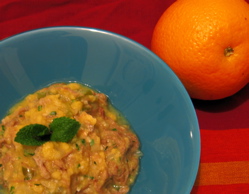A little cawl cymreig for Halloween howlers, and any other poor soul out in the chilly evenings. Cawl is a traditional farmhouse stew from Wales, very meaty and root-vegetable sweet. This is a great stew for cold weather, and it’s nippy here this week. Coming home tonight I saw a Guy flopped over stiffly on it’s box, at first glance totally abandoned. But no, its ten-year old patrons were indeed sitting behind it…and behind glass, inside the cafe with mugs of hot chocolate and an eye on their coins. Apparently they had decided that the risk of having the box snatched was less than the risk of hypothermia. Canny and sensible, or lazy and undeserving? I gave them 20p, even though everyone knows you shouldn’t give a penny for the Guy: they’ll just spend it on hot drink.
Back to the cawl. I swiftly browned pieces of lamb leg (and the bones from which the meat had been removed) in a little smoking sunflower oil, brought to boil, skimmed the foam, threw in some chopped onion and buckets of water, and left it to simmer all afternoon. It was getting toward suppertime when I fished out the bones, then added chopped swede (that’s the turnipy-rutabagaish creature), then parsnip, then carrot, then potato, then leek. There is a bit of judgment required in order to cook the vegetables appropriately – not too much, not too little, not to soon or lately added. Generations of farmhouse wisdom are behind such choreography; another forty years and I’ll have stew-perfection, as well as arthritis. For tonight, salt and lots of pepper to finish, and chopped parsley, if that’s not too fancy for the coal mines.
I’ll leave you with a few photos I took this past summer of Conwy Castle in north Wales, which I’m sure is quite spooky after dark. In medieval times the English (who were still a bit French at the time, truth be told) felt compelled to sit heavily upon the Welsh, who were so uppity as to think that the English should go home (preferably back to Normandy, but England would do) . The legacy for us today is a collection of very impressive fortifications liberally dotted along the green countryside. The very best castles are in the north of Wales, handy to Liverpool but a bloody long drive from everywhere else. Conwy is one of four famous castles in the area, and I saw a few other more modest ones on the sides of cliffs that no one seemed to know a thing about. Too many castles up here, who can keep track?

















